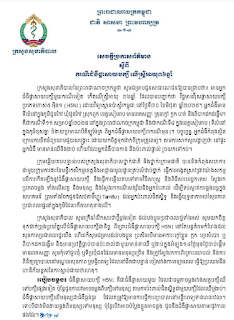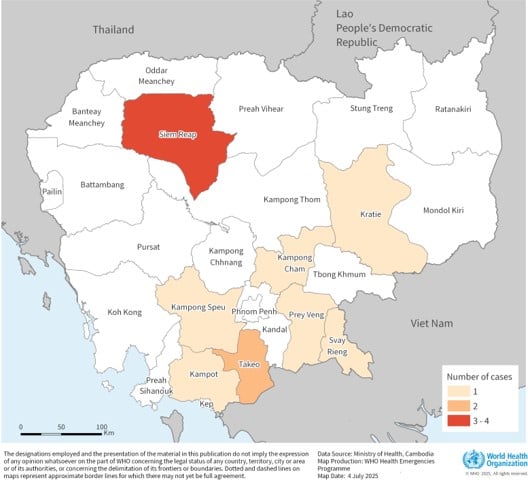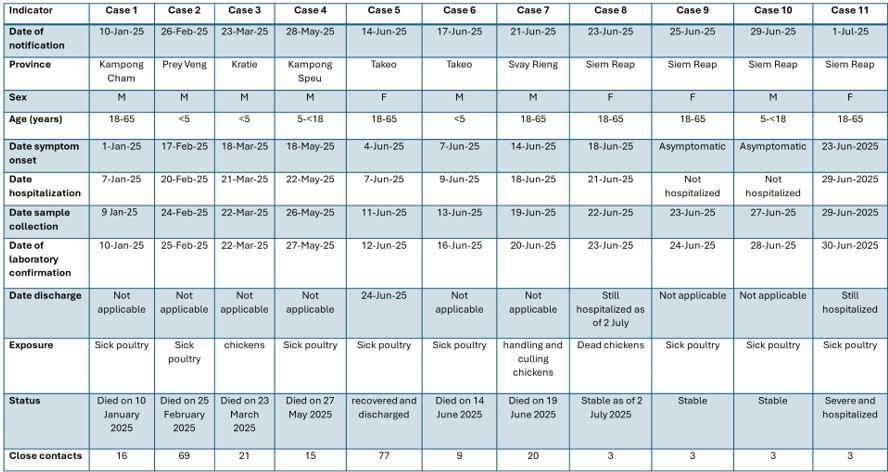Cambodia Reports 2 More Human H5N1 Cases for 2025

#18,774
According to my count, the latest update from the ECDC, and FluTracker's list, Cambodia has reported (prior to today) 7 human H5N1 cases, and 5 deaths in 2025.
Today they report 2 more cases from the same village as last week's case, which they describe as cases #9 & #10. Whether this is a misprint, or there is another case as yet unannounced, remains to be seen.
In any event, these two new cases were neighbors of last week's case, and are both reportedly in stable condition. Both families reportedly had contact with sick or dying chickens.
Unlike the milder 2.3.4.4b clade seen in the United States, Europe, and much of the rest of the world, recent cases from Cambodia and Vietnam have
stemmed from a resurgent older, and more virulent, clade (formerly clade 2.3.2.1c but recently redubbed as 2.3.2.1e).
The announcement (see screen shot below) was made overnight on the Cambodian MOH Facebook page. I've provided a translation (emphasis mine).
(Translation)
Kingdom of Cambodia
Ministry of Health
Press Release
2 more cases of bird flu
The Ministry of Health of the Kingdom of Cambodia would like to inform the public that, following an active investigation to find suspected cases and contacts in Lek village, Daun Keo commune, Puok district, Siem Reap province, the village where the 41-year-old woman tested positive for bird flu, which was reported on June 23, 2025, two more cases of bird flu were found, in a 46-year-old woman and a 16-year-old boy, who were mother and child and were confirmed to be positive for the H5N1 bird flu virus by the National Institute of Public Health. These are the 9th and 10th cases for 2025.
The two cases live approximately 20 meters away from the 41-year-old patient’s home. Currently, the health status of both patients is stable and they are being treated with Tamiflu with continued close monitoring. Investigations revealed that there were sick and dead chickens in the patient’s home, the neighbor’s home, and in the village. The patient had handled and touched sick and dead chickens and cooked them.
(Continue . . . )
Although Cambodia continues to do an admirable job of reporting hospitalized cases, it is entirely possible that some milder infections are going unreported. Severe or critical cases are far more likely to be hospitalized, tested, and confirmed as H5N1 positive.
While we are understandably focused on H5N1 clade 2.3.4.4b - clade 2.3.2.1e in Cambodia, the recently imported (ex India) clade 2.3.2.1a case in Australia, and > 90 H5N6 cases in China - remind us that HPAI H5 continues to evolve along multiple concurrent pathways.

#18,774
According to my count, the latest update from the ECDC, and FluTracker's list, Cambodia has reported (prior to today) 7 human H5N1 cases, and 5 deaths in 2025.
Today they report 2 more cases from the same village as last week's case, which they describe as cases #9 & #10. Whether this is a misprint, or there is another case as yet unannounced, remains to be seen.
In any event, these two new cases were neighbors of last week's case, and are both reportedly in stable condition. Both families reportedly had contact with sick or dying chickens.
Unlike the milder 2.3.4.4b clade seen in the United States, Europe, and much of the rest of the world, recent cases from Cambodia and Vietnam have
stemmed from a resurgent older, and more virulent, clade (formerly clade 2.3.2.1c but recently redubbed as 2.3.2.1e).
The announcement (see screen shot below) was made overnight on the Cambodian MOH Facebook page. I've provided a translation (emphasis mine).
(Translation)
Kingdom of Cambodia
Ministry of Health
Press Release
2 more cases of bird flu
The Ministry of Health of the Kingdom of Cambodia would like to inform the public that, following an active investigation to find suspected cases and contacts in Lek village, Daun Keo commune, Puok district, Siem Reap province, the village where the 41-year-old woman tested positive for bird flu, which was reported on June 23, 2025, two more cases of bird flu were found, in a 46-year-old woman and a 16-year-old boy, who were mother and child and were confirmed to be positive for the H5N1 bird flu virus by the National Institute of Public Health. These are the 9th and 10th cases for 2025.
The two cases live approximately 20 meters away from the 41-year-old patient’s home. Currently, the health status of both patients is stable and they are being treated with Tamiflu with continued close monitoring. Investigations revealed that there were sick and dead chickens in the patient’s home, the neighbor’s home, and in the village. The patient had handled and touched sick and dead chickens and cooked them.
The emergency response teams of the national and sub-national ministries of health have been collaborating with the provincial agriculture departments and local authorities at all levels to actively investigate the outbreak of bird flu and respond according to technical methods and protocols, find sources of transmission in both animals and humans, and search for suspected cases and contacts to prevent further transmission in the community. They have also distributed Tamiflu to close contacts and conducted health education campaigns among residents in the affected villages.
The Ministry of Health would like to remind all citizens to always pay attention to and be vigilant about bird flu because H5N1 bird flu continues to threaten the health of our citizens. We would also like to inform you that if you have a fever, cough, sputum discharge, or difficulty breathing and have a history of contact with sick or dead chickens or ducks within 14 days before the start of the symptoms, do not go to gatherings or crowded places and seek consultation and treatment at the nearest health center or hospital immediately. Avoid delaying this, which puts you at high risk of eventual death.
(Continue . . . )
Although Cambodia continues to do an admirable job of reporting hospitalized cases, it is entirely possible that some milder infections are going unreported. Severe or critical cases are far more likely to be hospitalized, tested, and confirmed as H5N1 positive.
While we are understandably focused on H5N1 clade 2.3.4.4b - clade 2.3.2.1e in Cambodia, the recently imported (ex India) clade 2.3.2.1a case in Australia, and > 90 H5N6 cases in China - remind us that HPAI H5 continues to evolve along multiple concurrent pathways.














Comment